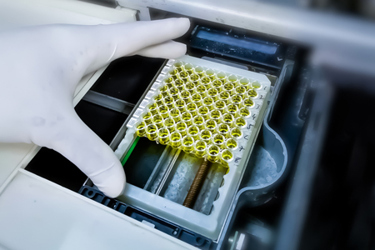A Checklist For Mechanism-Based Potency Testing In Cell Therapy
By Christina M. Celluzzi, Association for the Advancement of Blood & Biotherapies

In the expanding landscape of cell-based therapies, few topics generate more discussion — and confusion — than potency. Regulatory agencies require that every product demonstrates potency, yet defining and measuring it in a clinically relevant way remains one of the field’s most persistent challenges.
In a pair of papers published in the Journal of Translational Medicine, Simon et al.1,2 offer a much-needed reframing. They propose a cohesive approach that connects the mechanism of action (MoA) of a cellular therapy with the design, selection, and interpretation of potency assays. The work was a collaboration among diverse leaders in cell therapy, including representatives from major companies, government agencies, and organizations. I am a contributing co-author representing the Association for the Advancement of Blood & Biotherapies (AABB). The research is especially relevant to institutions operating under the AABB Standards for Cellular Therapy Services,3 which emphasize the need for well-justified, consistent, and biologically meaningful potency testing.
We begin with the premise that potency cannot be decoupled from a product’s MoA. Understanding what the cells do — whether through immunomodulation, trophic support, engraftment, or other biological functions — is essential for selecting assays that accurately reflect therapeutic potential. This idea aligns with AABB’s standards, which require that a relevant functional assay specific to the cellular therapy product is performed, and that relevant potency assays is defined. By placing MoA at the center of assay design, we emphasize that potency testing must do more than produce a number — it must tell a story about how the product works.
A major contribution of our work is the critique of many common potency assays. Too often, developers rely on simple surrogate markers — such as cell surface proteins or single cytokine readouts — that may be reproducible but fail to capture functional relevance. We advocate instead for multiparameter, mechanism-informed assays that are better suited to capturing the complexity of living products. These insights align with the AABB standards emphasizing that potency testing must be sensitive enough to detect changes that may affect therapeutic efficacy, and that the testing method must be scientifically justified and validated. AABB’s emphasis on method validation, documentation, and review across the product life cycle provides a strong operational framework for implementing the kind of potency testing that the authors envision.
Where we push for conceptual clarity, AABB provides the structural scaffolding. The Standards for Cellular Therapy Services offer a framework for developing, validating, and applying testing, ensuring that they are appropriate for the product type, development phase, and clinical context. These standards encourage defined and documented MoA or intended function, demonstration that potency testing reflects function, and routine review and revalidation as products evolve. We go a step further, suggesting the integration of emerging tools — omics, systems biology, and digital analytics — to refine and personalize potency testing. AABB’s standards already allow flexibility in assay selection and encourage innovation, provided there is scientific and operational justification.
Together, the papers’ framework and AABB’s standards point to a future where potency testing is both rigorous but also clinically meaningful. Developers are encouraged to integrate MoA mapping early in product development, justify assay selection through direct links to intended function, and use AABB’s quality and documentation requirements to maintain consistency and traceability. In an era where therapies are becoming more personalized, and products more complex, the alignment between science and standards will be key. The synergy between our recommendations and AABB’s established quality framework4 offers a clear and achievable path toward better, more reliable potency testing, improving patient outcomes, and accelerating the translation of novel therapies into clinical care.
AABB standards provide flexibility across product types and development phases, while maintaining a focus on scientific rigor and patient safety. By aligning potency testing with the MOA, developers can meet regulatory expectations and improve outcomes. Together, our recommendations and AABB’s quality framework provide a road map for developers navigating the evolving cell therapy landscape.
Designing Mechanism-Informed Potency Testing
Ensuring the potency of cellular products is crucial for their therapeutic success. However, defining and measuring potency in a biologically meaningful way remains challenging. This sidebar provides a practical checklist for developers and quality teams emphasizing the importance of grounding potency in the mechanism of action (MoA) and aligning with the AABB Standards for Cellular Therapy Services. By following these guidelines, teams can design, validate, and monitor potency assays that truly reflect the therapeutic potential of their products, improving patient outcomes and advancing the field.
Checklist for mechanism-informed potency testing
- Start with MoA:
- Clearly define the intended function of the cell product.
- Identify the biological pathways involved in therapeutic effect.
- Use preclinical or translational models to support MoA.
- Select Assays That Reflect Function:
- Choose assays linked to MoA, not just surrogate markers.
- Use multiparameter or functional readouts if MoA is complex.
- Ensure in vitro results correlate with clinical outcomes where possible.
- Validate and Justify:
- Confirm assay sensitivity to changes in product quality.
- Provide scientific rationale for assay choice and method.
- Document performance characteristics (accuracy, specificity, linearity, etc.).
- Review and Reassess:
- Revalidate potency tests after manufacturing changes.
- Monitor assay performance during routine production.
- Use assay data as part of product comparability assessments.
- Embrace Innovation (Thoughtfully):
- Integrate omics, systems biology, or imaging if they support MoA.
- Maintain interpretability and reproducibility.
- Align innovative tools with regulatory and accreditation expectations.
References:
- Mechanism of action, potency and efficacy: considerations for cell therapies, Simon, C.G., Bozenhardt, E.H., Celluzzi, C.M. et al. Mechanism of action, potency and efficacy: considerations for cell therapies. J Transl Med 22, 416 (2024). https://doi.org/10.1186/s12967-024-05179-7
- Analysis of the measurements used as potency tests for the 31 U.S. FDA-approved cell therapy products, Simon, C.G., Bozenhardt, E.H., Celluzzi, C.M. et al. Analysis of the measurements used as potency tests for the 31 U.S. FDA-approved cell therapy products. J Transl Med 23, 259 (2025). https://doi.org/10.1186/s12967-025-06253-4
- Association for the Advancement of Blood and Biotherapies. AABB Standards for Cellular Therapy Services. Accessed April 10, 2025. https://www.aabb.org/standards-accreditation/standards/cellular-therapy-services.
- Association for the Advancement of Blood and Biotherapies. Quality. Accessed April 10, 2025. https://www.aabb.org/standards-accreditation/quality.
About The Author:
 Christina Celluzzi, Ph.D., M.S., CABP(H), is director of biotherapies for the Association for the Advancement of Blood & Biotherapies where she supports professional development by helping create educational content, engage with members, and serve as a key resource to the biotherapies community. She contributed to the development of the AABB Certified Advanced Biotherapies Professional (CABP) credential, which impacts the field by enhancing the identification and retention of qualified professionals- fostering credibility and recognition. Previously, she was a research scientist where she developed dendritic cell closed-culture systems and supporting assays for clinical application as a research scientist and faculty member of the American Red Cross Holland Biomedical Laboratory and the University of Maryland School of Medicine. She received her Ph.D. in medical sciences from the University of Nijmegen in the Netherlands. Learn more at www.aabb.org/biotherapies.
Christina Celluzzi, Ph.D., M.S., CABP(H), is director of biotherapies for the Association for the Advancement of Blood & Biotherapies where she supports professional development by helping create educational content, engage with members, and serve as a key resource to the biotherapies community. She contributed to the development of the AABB Certified Advanced Biotherapies Professional (CABP) credential, which impacts the field by enhancing the identification and retention of qualified professionals- fostering credibility and recognition. Previously, she was a research scientist where she developed dendritic cell closed-culture systems and supporting assays for clinical application as a research scientist and faculty member of the American Red Cross Holland Biomedical Laboratory and the University of Maryland School of Medicine. She received her Ph.D. in medical sciences from the University of Nijmegen in the Netherlands. Learn more at www.aabb.org/biotherapies.
